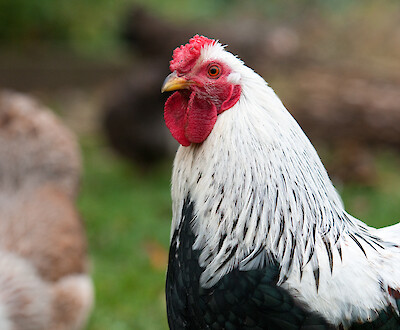The right foal feeding lays the foundation for the healthy development of a horse. In the first weeks and months, the horse's body grows rapidly. Especially now, your foal has a high demand for vital nutrients. If it is not properly fed at this time, there is a risk of undersupply and associated developmental problems. The correct feeding of your foal sets the course for its further development into a full-grown mare, gelding or stallion.
Colostrum: The first milk ensures the supply of the foal in the first hours
The first source of nutrition for the newborn foal is colostrum. This is the mare's first milk. The colostrum - also called first milk, colostrum or colostrum - contains lots of protein and vitamin A. In addition to providing nutrients, colostrum is particularly important for your foal for another reason: It contains antibodies that strengthen your foal's still undeveloped immune system. This is especially important for survival in the first weeks of life.
Directly after birth, your foal does not yet have its own antibodies against harmful pathogens. The foal's immune system is not yet fully developed after birth. It does not produce its own antibodies until it is about four months old. The mare's colostrum contains antibodies or immunoglobulins that protect the foal from infections until its own immune system is fully developed. However, the amount of defence substances in the first milk continues to decrease after birth.
Therefore, it is important that foals take colostrum directly within the first hours after birth. The reason: the level of immunoglobulins in colostrum drops to 1/6 of the initial concentration after 4-8 hours. If the foal does not come to the mare's udder, the first milk must therefore be administered promptly by bottle or - if the swallowing reflex is not yet developed - by a veterinarian via a nasogastric tube.
The mare's milk ensures a healthy foal
After the colostrum has dried up, the mare's milk is the young horse's main source of nutrition during the first weeks of life. It provides it with sufficient protein and energy for its growth and has an optimal composition of all relevant nutrients. The prerequisite for a sufficient milk production is, on the one hand, a fit and healthy mare. On the other hand, she should be supplied with sufficient nutrients.
During their first weeks of life, foals usually suckle at their mother's teats 50 times a day. A foal of medium-sized breeds takes in about 150-250 ml of milk per meal. You can tell if the mare is producing enough milk by the foal's suckling behaviour. If the foal is excited while sucking and keeps changing teats restlessly, this is usually an indication of too little milk in the mother's udder. Check whether the mare has drunk enough water. The water requirement of a lactating mare is about 8 litres per 100 kg body weight. If the mare is self-watering, the water flow should be checked regularly. If the mare is in generally poor body condition, the feeding should possibly be adjusted. A check-up via the veterinarian can also be useful, for example to rule out an inflammation of the mare's udder.
Development and growth of the foal: This is how young horses grow up
The body of horses grows much faster than that of many other mammals. As nest-fugitives, foals can already stand on all four legs and suckle from their mother after 15 minutes to 2 hours. On its first day of life, it can already follow the mother mare over longer distances.
At birth, a foal has about 10 percent of the weight and about 60 to 65 percent of the size of an adult horse.

Within the first three months, a foal gains an enormous amount of weight every day. After about two months, it has doubled its birth weight. This corresponds to a weight gain of about 1,000 grams per day. Thoroughbreds and warmblood breeds grow even faster than ponies and robust horses.
Always make sure that your foal has a healthy constitution. It should be neither too fat nor too thin. As the foal develops in stages, you can prevent deficiencies during developmental phases. At the same time you avoid unnecessary overweight, which can lead to metabolic problems in adulthood
Why is my foal eating its faeces?
If you notice that your foal is eating its mother's faeces during the first weeks of its life, there is no need to worry. This is a completely normal behaviour. It ensures that the foal's intestine is colonised with vital bacteria. In addition, the faeces of the mother mare supports the supply of vitamin B to your foal. Eating faeces has many positive qualities - so don't prevent it. If it still bothers you, don't worry: after all, the behaviour will disappear as the foal grows older.
Rearing feeding and start of solid food intake
During the second month of life, the foal begins to eat solid food. It starts playfully at first by imitating the mare. The young horses usually eat pasture grass and hay at first. The beginning of eating solid food indicates that the foal's body is developed enough to utilise and digest the new food source. From this point on, therefore, the phase of rearing feeding begins.
This is also related to the gradual reduction of the mare's milk yield. Due to the drop in milk yield, the milk is no longer sufficient in quantity, but also in quality, for the sole supply of the foal

For you, this means: from this point on, you should ensure the foal's nutrient supply with additional feeding. It also supports the foal's development and supports its growth. After all, your foal's skeleton and musculoskeletal system can only develop optimally if the nutrient supply is ensured even in this difficult phase. A deficiency or imbalance in the feeding of foals and weanlings can, for example, reduce hoof quality, cause growth problems and diseases of the musculoskeletal system (e.g. joint chips)
Essential nutrients for foals in the rearing phase
In the rearing phase, foals need the following nutrients in particular and in sufficient quantities:
- Protein
- essential amino acids (especially lysine, cysteine and methionine)
- Trace elements (especially zinc, copper and iodine)
- Minerals (especially calcium, phosphorus and magnesium)
Minerals, together with zinc and copper, are necessary for the development of a stable and resilient musculoskeletal system. The essential amino acids lysine, cysteine and methionine support muscle development. Especially in the first year of life, you should therefore make sure that your child has a sufficient supply. During this time, your foal's protein requirements are at their highest. After that, your young horse grows slowly and the requirement decreases.
How to choose the right foal food
A mineralised concentrate is suitable as rearing feed for your foal, which optimally covers the high nutrient requirements of your foal (see above). Appropriate breeding feeds for horses (e.g deukavallo breeding muesli) are rich in protein, highly vitaminised and mineralised and contribute to the comprehensive provision of the foal with all vital vitamins and trace elements in its first year of life. A great advantage is the feeding of a breeding muesli, with which you can feed foal and mare at the same time. This makes it easier for you to feed the foal, as the curious foals imitate their mother's feeding from the trough. If you end up feeding the broodmare and foal together, feed the foal through a special foal trough. This prevents the mother mare from eating your foal's food.
In addition to feeding a feed specially designed for breeding and rearing, such as deukavallo Zuchtmüsli, it is also possible to mix your own feed if suitable components are already available on the farm. For example, a ration of rolled oats (e.g deukavallo rolled oats) and soya meal with a suitable mineral feed (e.g deukavallo mineral) can ensure that the foal is fully supplied
The latter, however, requires some experience as well as a certain knowledge of horse nutrition.
No matter what you decide: When choosing the right rearing feed for your foal, good mineralisation is the be-all and end-all. Grass, hay or a feed without added minerals alone will not be enough for your foal.
Weaning the foal: feeding the weanling correctly
The weaning of the foal represents a very drastic phase of life for foal and bro odmare - at least in our domesticated horses. In the wild, weaning does not occur in this way. Yearlings drink with their mother until she is expecting the next foal. Also, a young horse does not leave its natal herd until it is one year old at the earliest (but often much later). While fillies usually stay with the herd, colts are chased away when they reach sexual maturity.
In human care, foals are usually separated from their mothers at around six months of age. The gentler the weaning, the better it is for the foal. One solution could be to separate the foal from the mother mare for a few hours at a time, but always with other foals of the same age.
However, even such a "gentle" solution is a stressful experience in the foal's life. Stress always leads to an increased need for nutrients - this applies to adult horses as well as foals. This is often compounded by the fact that foal weaning (and the associated loss of nutrient-rich mother's milk) often takes place in autumn. After the end of the grazing season, foals can no longer compensate for the lack of nutrients in their mother's milk by consuming energy- and nutrient-rich pasture grass. For this reason, it is even more important to continue the breeding muesli during the winter season (stable period) until the first year of life. As soon as the yearlings are put out to pasture in spring, the breeding feed should be reduced step by step. In addition to the pasture grass, a mineral feed or - depending on the quality of the pasture - a mineralised basic crib feed (e.g Top E or Top Mix). It is essential to wean your foal only when it is eating independently and sufficiently. This is the only way to ensure the supply of all relevant nutrients through roughage, concentrated feed and mineral feed during this critical phase.
Conclusion: Feeding foals correctly: How to feed your foal correctly
-
During the first weeks of life, the mare's breast milk provides the foal with all the vitamins and minerals it needs for its development.
-
From the second month of life, the foal begins to eat solid food for the first time. In doing so, it imitates its mother. From this point on, feeding can begin.
-
An adequate supply of nutrients plays an important role in the proper development of the foal. As the foal grows particularly rapidly during the first months, you must avoid a deficient supply at all costs in order to prevent growth disorders.
-
A well-mineralised breeding muesli (e.g. deukavallo Mineral ) is ideal as a starting feed deukavallo breeding muesli) is ideal for feeding your foal and at the same time for the mare. It contains all the vitamins and minerals the foal needs for its development.
-
The weaning phase is associated with stress for the foal and therefore with a high nutritional requirement. Weaning should only take place when the foal is eating independently and in sufficient quantities. Mineralised concentrated feeds (e.g. deukavallo Breeding Muesli) or a hay ration with balanced mineral feeds (e.g. deukavallo Mineral) are suitable for feeding.
Image sources: © kwadrat70 - stock.adobe.com (top slider) / © matilda553 - stock.adobe.com
Contact person

Barbara Wefers
Contact person

























